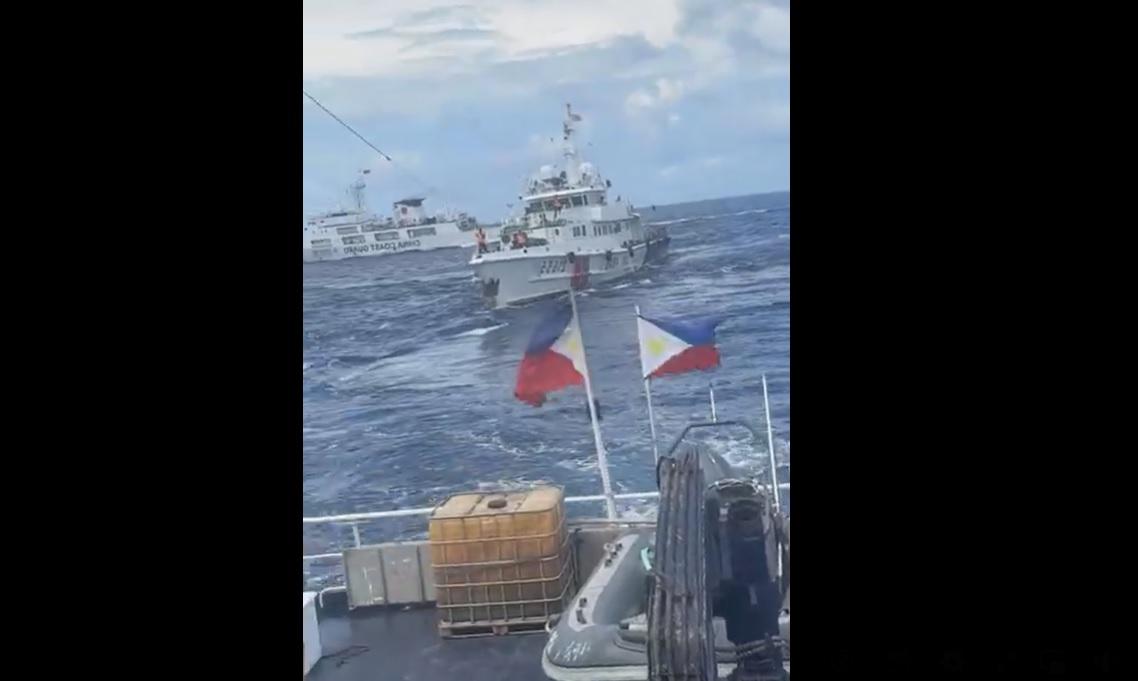China Coast Guard vessels ram, use water cannon vs. PH vessel going to Escoda Shoal

China Coast Guard (CCG) vessels rammed and used a water cannon on the BRP Datu Sanday of the Bureau of Fisheries and Aquatic Resources near Escoda Shoal on Sunday.
In GMA Integrated News reporter Ian Cruz’s live report, two other CCG ships could be seen following the BRP Datu Sanday.
The CCG once again rammed BRP Datu Sanday before keeping its distance.
Another CCG vessel then used a water cannon on BRP Datu Sanday.
A Chinese militia vessel was also seen approaching.
The CGG vessel rammed the BRP Datu Sanday at least five times, Cruz reported.
He added that the Chinese ships had been surrounding the Datu Sanday since 10:30 a.m.
The CCG vessels surrounding the BRP Datu Sanday continued to use its water cannons, with some aiming at the roof where its navigational equipment is located.
BRP Datu Sanday was seen being water cannoned before Cruz's live report ended.
GMA News Online had sought comments from the Philippine Coast Guard, the Presidential Communications Office, and the National Maritime Council (NMC).
In a statement, The CCG claimed that BRP Datu Sanday “illegally stormed” into China’s territory and continued to approach their vessels in a “dangerous manner.”
“The China Coast Guard took control measures against the Philippines vessel involved in the incident in accordance with law and regulations,” CGG said.
For its part, China state broadcaster CCTV said that "[b]ased on humanitarian principles, China immediately rescued the Philippine people who fell into the water. We warn the Philippine side to immediately stop the infringement, otherwise the Philippine side will bear all the consequences arising therefrom."
Meanwhile, the Philippine National Security Council (NSC) called the CCG’s claims “completely unfounded.”
“This fake news and misinformation serves as a clear illustration of the People’s Republic of China’s willingness to distort the truth and engage in disinformation to bolster its public image,” NSC said.
“The Philippine government calls on the People’s Republic of China to halt these provocative actions that destabilize regional peace and security. The Philippines remains steadfast in asserting its rights in accordance with the United Nations Conventions on the Law of the Sea and the 2016 Arbitral Award.,” it added.
BRP Datu Sanday was set on a humanitarian mission from Hasa-Hasa Shoal to deliver diesel, food, and medical supplies to Filipino fishermen in Escoda Shoal
Hasa-Hasa Shoal is located 60 nautical miles from Palawan.
According to the NSC, the “aggressive and dangerous” maneuvers of eight Chinese vessels led to BRP Datu Sanday’s engine failure, forcing an early termination of the humanitarian operation.
“These unprofessional, aggressive, and illegal actions posed serious risks to the safety of the Filipino crew and the fishermen they were meant to serve,” NSC said.
The crew onboard BRP Datu Sanday was safe, NSC added.
The US and the European Union expressed concern over the incident.
"Unsafe, unlawful, and aggressive conduct by the PRC disrupted a legal [Philippine] mission, endangering lives—the latest in multiple dangerous actions by the PRC. We are steadfast in supporting our [Philippine friends, partners, allies],” US Ambassador MaryKay Carlson said, while EU Ambassador Luc Veron called the ramming "disturbing."
“The EU trusts that respect for international law including UNCLOS is essential in the South China Sea as anywhere else,” he said.
In a statement, Senator Jinggoy Estrada urged government agencies to "explore all legal avenues, including the possibility of having an international arbitration to step in to hold China accountable for its repeated and dangerous maneuvers against our vessels."
In a separate release, Senator Loren Legarda said the ramming was "not only illegal but inhumane and cruel to safety of those at sea."
Earlier this week, a CCG vessel and the PCG's BRP Bagacay collided near the Escoda Shoal.
NMC spokesperson Alexander Lopez said the Philippine government was looking into possibly filing a case against China following the August 19 collision.
According to PCG spokesperson on the West Philippine Sea Commodore Jay Tarriela, the collision may be considered the worst crash incident experienced by the PCG.
The Escoda Shoal, also known as Sabina Shoal, is within the Philippines’ 200-nautical mile exclusive economic zone (EEZ) under the 1982 United Nations Convention on the Law of the Sea.
It is located 75 nautical miles or about 140 kilometers off Palawan.
Collisions between Philippine vessels and Chinese ships have been recorded in other areas of the West Philippine Sea, with a service member of the Philippine Navy suffering a “severe injury” during a regular rotation and resupply (RORE) mission in the Ayungin Shoal in June.
Beijing on Saturday, June 15, started its “no trespassing” policy that allowed the China Coast Guard to detain “foreign trespassers” in its massive territorial claims for up to 60 days without trial.
To recall, the Philippines in 2013 challenged China over its claims on the West Philippine Sea, where Manila scored a victory and a landmark ruling by an international tribunal which invalidated Beijing’s claims.
China has refused to acknowledge the Permanent Court of Arbitration’s 2016 ruling that invalidated its nine-dash line. Its government in 2022 claimed that it will continue to adhere to what it described as a “friendly consultation” with the Philippines after several Chinese vessels have been found “swarming” areas in the West Philippine Sea.
The Philippines has already filed a total of 153 diplomatic protests against China regarding the territorial dispute under the administration of President Ferdinand “Bongbong” Marcos Jr. — Mariel Celine Serquiña/Jon Viktor Cabuenas/KG/DVM/BM, GMA Integrated News




